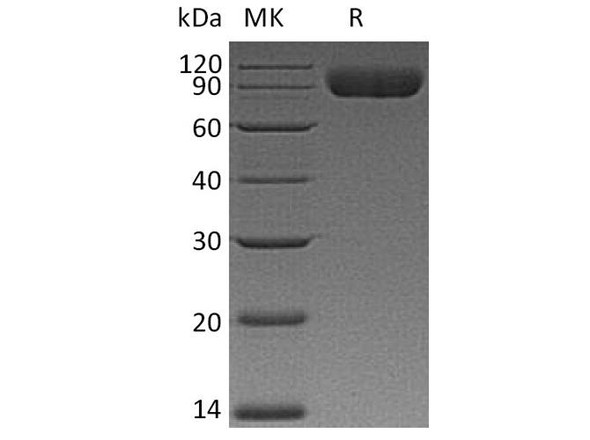Description
| Product Name: | Human SIRPA Recombinant Protein |
| Product Code: | RPPB4686 |
| Size: | 20µg |
| Species: | Human |
| Target: | SIRPA |
| Synonyms: | Signal-Regulatory Protein Alpha, SHPS1, CD172Antigen-Like Family Member A, Inhibitory Receptor SHPS-1, Macrophage FusionReceptor, PTPNS1, SIRP, P84, BIT, MFR, Brain-Immunoglobulin-Like Molecule With Tyrosine-BasedActivation Motifs, Brain Ig-Like Molecule With Tyrosine-Based ActivationMotifs, Protein Tyrosine Phosphatase, Non-Receptor Type Substrate 1, Tyrosine-ProteinPhosphatase Non-Receptor Type Substrate 1, Tyrosine Phosphatase SHP Substrate1, Signal-Regulatory Protein Alpha-1 , ignal-Regulatory Protein Alpha-2, Signal-RegulatoryProtein Alpha-3, SHP Substrate 1, CD172a Antigen, Myd-1 Antigen, MyD-1 Antigen,Sirp-Alpha-1, Sirp-Alpha-2, Sirp-Alpha-3, CD172A, SHPS-1, MYD-1, MYD1, Tyrosine-proteinphosphatase non-receptor type substrate 1. |
| Source: | Escherichia Coli |
| Physical Appearance: | Sterile Filtered colorless solution. |
| Formulation: | SIRPA protein solution (0.5mg/ml) containing PBS buffer(pH 7.4), 10% glycerol and 1mM DTT. |
| Stability: | Store at 4°C if entire vial will be used within 2-4 weeks. Store, frozen at -20°C for longer periods of time. For long term storage it is recommended to add a carrier protein (0.1% HSA or BSA).Avoid multiple freeze-thaw cycles. |
| Purity: | Greater than 90.0% as determined by SDS-PAGE. |
| Amino Acid Sequence: | MGSSHHHHHH SSGLVPRGSH MGSGVAGEEE LQVIQPDKSV LVAAGETATL RCTATSLIPV GPIQWFRGAGPGRELIYNQK EGHFPRVTTV SDLTKRNNMD FSIRIGNITP ADAGTYYCVK FRKGSPDDVE FKSGAGTELSVRAKPSAPVV SGPAARATPQ HTVSFTCESH GFSPRDITLKWFKNGNELSD FQTNVDPVGE SVSYSIHSTA KVVLTREDVH SQVICEVAHVTLQGDPLRGT ANLSETIRVP PTLEVTQQPV RAENQVNVTC QVRKFYPQRL QLTWLENGNV SRTETASTVTENKDGTYNWM SWLLVNVSAH RDDVKLTCQV EHDGQPAVSK SHDLKVSAHP KEQGSNTAAENTGSNERNIY |
Signal-Regulatory Protein Alpha, SIRPA belongs to thesignal-regulatory-protein (SIRP) family, as well as the immunoglobulin super family. The membersof the SIRP family are receptor-type�transmembrane glycoproteins which are involved in the negative regulation of receptor tyrosinekinase-coupled signaling processes. SIRPA can be phosphorylatedby tyrosine kinases. The phospho-tyrosine residues of this PTP have been shownto recruit SH2 domaincontaining tyrosine phosphatases (PTP), and perform as substrates of PTPs.� SIRPA take part in signal transduction mediated by a varietyof growth factor receptors. CD47 has been shown to be a ligand for �SIRPA.
SIRPA Human Recombinant produced in E.Coli is a single,non-glycosylated polypeptide chain containing 370 amino acids (27-373 a.a) andhaving a molecular mass of 40.4kDa.SIRPA is fused to a 23 amino acid His-tag at N-terminus& purified by proprietary chromatographic techniques.
| UniProt Protein Function: | SHPS1: Immunoglobulin-like cell surface receptor for CD47. Acts as docking protein and induces translocation of PTPN6, PTPN11 and other binding partners from the cytosol to the plasma membrane. Supports adhesion of cerebellar neurons, neurite outgrowth and glial cell attachment. May play a key role in intracellular signaling during synaptogenesis and in synaptic function. Involved in the negative regulation of receptor tyrosine kinase-coupled cellular responses induced by cell adhesion, growth factors or insulin. Mediates negative regulation of phagocytosis, mast cell activation and dendritic cell activation. CD47 binding prevents maturation of immature dendritic cells and inhibits cytokine production by mature dendritic cells. Binds PTPN11 when tyrosine-phosphorylated, except in macrophages, where it primarily binds PTPN6. Binds GRB2 in vitro. Binds FGR. Binds JAK2 irrespective of its phosphorylation status and forms a stable complex. Binds SCAP1 and/or SCAP2. The resulting complex recruits FYB. Binds PTK2B. Ubiquitous. Highly expressed in brain. Detected on myeloid cells, but not T-cells. Detected at lower levels in heart, placenta, lung, testis, ovary, colon, liver, small intestine, prostate, spleen, kidney, skeletal muscle and pancreas. 3 isoforms of the human protein are produced by alternative splicing. |
| UniProt Protein Details: | Protein type:Cell surface; Motility/polarity/chemotaxis; Cell adhesion; Receptor, misc.; Membrane protein, integral Chromosomal Location of Human Ortholog: 20p13 Cellular Component: membrane; integral to membrane; plasma membrane Molecular Function:SH3 domain binding Biological Process: blood coagulation; cell adhesion; leukocyte migration |
| NCBI Summary: | The protein encoded by this gene is a member of the signal-regulatory-protein (SIRP) family, and also belongs to the immunoglobulin superfamily. SIRP family members are receptor-type transmembrane glycoproteins known to be involved in the negative regulation of receptor tyrosine kinase-coupled signaling processes. This protein can be phosphorylated by tyrosine kinases. The phospho-tyrosine residues of this PTP have been shown to recruit SH2 domain containing tyrosine phosphatases (PTP), and serve as substrates of PTPs. This protein was found to participate in signal transduction mediated by various growth factor receptors. CD47 has been demonstrated to be a ligand for this receptor protein. This gene and its product share very high similarity with several other members of the SIRP family. These related genes are located in close proximity to each other on chromosome 20p13. Multiple alternatively spliced transcript variants have been determined for this gene. [provided by RefSeq, Jul 2008] |
| UniProt Code: | P78324 |
| NCBI GenInfo Identifier: | 91105764 |
| NCBI Gene ID: | 140885 |
| NCBI Accession: | NP_001035111.1 |
| UniProt Secondary Accession: | P78324,O00683, O43799, Q8N517, Q8TAL8, Q9H0Z2, Q9UDX2 Q9UIJ6, Q9Y4U9, A2A2E1, A8K411, B2R6C3, |
| UniProt Related Accession: | P78324 |
| Molecular Weight: | 54,967 Da |
| NCBI Full Name: | tyrosine-protein phosphatase non-receptor type substrate 1 |
| NCBI Synonym Full Names: | signal-regulatory protein alpha |
| NCBI Official Symbol: | SIRPA�� |
| NCBI Official Synonym Symbols: | BIT; MFR; P84; SIRP; MYD-1; SHPS1; CD172A; PTPNS1�� |
| NCBI Protein Information: | tyrosine-protein phosphatase non-receptor type substrate 1; myd-1 antigen; inhibitory receptor SHPS-1; macrophage fusion receptor; CD172 antigen-like family member A; tyrosine phosphatase SHP substrate 1; brain-immunoglobulin-like molecule with tyrosine-b |
| UniProt Protein Name: | Tyrosine-protein phosphatase non-receptor type substrate 1 |
| UniProt Synonym Protein Names: | Brain Ig-like molecule with tyrosine-based activation motifs; Bit; CD172 antigen-like family member A; Inhibitory receptor SHPS-1; Macrophage fusion receptor; MyD-1 antigen; Signal-regulatory protein alpha-1; Sirp-alpha-1; Signal-regulatory protein alpha-2; Sirp-alpha-2; Signal-regulatory protein alpha-3; Sirp-alpha-3; p84 |
| Protein Family: | Nonribosomal peptide synthetase |
| UniProt Gene Name: | SIRPA�� |
| UniProt Entry Name: | SHPS1_HUMAN |






